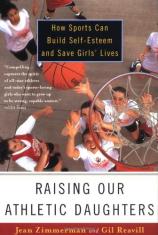Reading Group Guide
Discussion Questions
Raising Our Athletic Daughters: How Sports Can Build Self-Esteem and Save Girls' Lives

1. Parents' personal history colors their approach to introducing their daughters to sports. What were some of your own sports-related experiences growing up?
2. More people tuned in to televised coverage of the Women's World Cup in Summer '99 than the NBA finals the same year, seemingly disproving the theory that there is no large-scale audience for televised female athletic events. Was it a fluke or a trend?
3. The authors cite studies saying that 95 percent of national sports coverage focuses on male athletes. They say the trend has begun to shift in other venues. How are local newspapers' coverage of women's and girls' sports different, and why? What difference does it make to girls what sports get covered in the media?
4. The authors make the claim that playing sports not only boosts girls' confidence and enhances their physical well-being, but can even "save girls' lives." What evidence is there to support this assertion? Do you know girls for who this conclusion is true?
5. Debate exists regarding the benefits of same sex or coed sports participation. What are some of the advantages and disadvantages of each?
6. What about athletic activities that are traditionally "boys only"--such as wrestling, ice hockey, football, boxing--what are the benefits for girls of taking part? Is there a downside? Are they different than participating in more "feminine" sports--like swimming, gymnastics, tennis?
7. Kate Morrel is a soccer player whose teammates helped her through a tough time. Have you ever played on a team that felt like family?
8. Girls' games are not often capable of drawing big crowds of spectators, something girls in the book note with disappointment. Why does it matter--and who do girls want most in the stands cheering them on?
9. Fathers and athletic daughters share an unusual bond. What are some of the advantages that a father might bring to his daughters sports experience? Disadvantages?
10. The authors assert that how we treat girls and boys even before they start kindergarten shapes their later sports participation and ability. What messages do we send by putting girls in tutus and boys in dungarees, or by scolding girls when they come in dirty from playing outside?
11. The hours of 3 to 8 pm have been described by child professionals as "the witching hours." Why? In addition to the teen crime rate tripling, the teen pregnancy rate also rises. What's the relationship researchers have found between girls' physical activity and premarital sex?
12. Kids play neighborhood pickup games less frequently than they did years ago. Instead, we have much more adult-organized team play. What are the pluses and minuses of this evolution?
13. The authors describe the boom in girls' sports involvement as a "children's crusade." What evidence do they cite for this view? What are some of the obstacles to equal sports participation for girls?
14. What are some of the barriers in schools to girls' sports participation? What can parents do to monitor what goes on in their kids' school?
15. What are some of the sporting events of the last several years that have altered the public expectation for women athletes and fueled girls' desire to play?
16. The authors profile a number of young athletes throughout the book. What are some of the more memorable characters? Did any of the girls remind you of a girl you know? Did the descriptions of girls' personalities ring true?
17. The book talks about the role of some especially devoted coaches. What makes them good? Talk about your own experience with coaches. Do you remember a standout coach?
18. Corporate America is taking notice of the explosion in sports for women. Examples? Why is business so interested?
19. How do some coaches ensure that kids excel academically as well as athletically? Can you think of an example the authors give of a high school student who was motivated by her sports involvement to improve her academic performance?
20. It's been said that while sports teach boys what they must be, they teach girls what they can be. Can you explain what this means? While physical activity is good for all kids, do you think it holds particular advantages for girls? If so, what are they?
21. "Not to have confidence in one's body is to lose confidence in oneself," wrote Simone de Beauvoir. Social theorists like Mary Pipher have described the culture we inhabit as "girl poisoning." What kinds of features make girls lose confidence in their bodies and how can physical activity help girls regain a healthy body image?
Raising Our Athletic Daughters: How Sports Can Build Self-Esteem and Save Girls' Lives
- Publication Date: September 25, 2012
- Paperback: 255 pages
- Publisher: Main Street Books
- ISBN-10: 0385489609
- ISBN-13: 9780385489607








